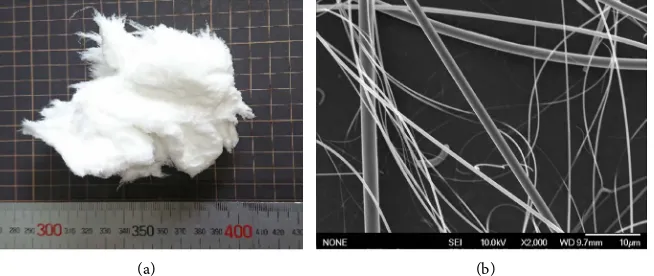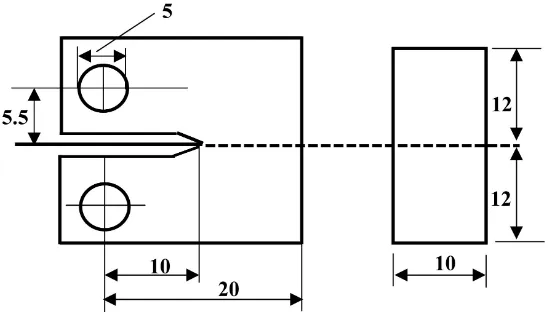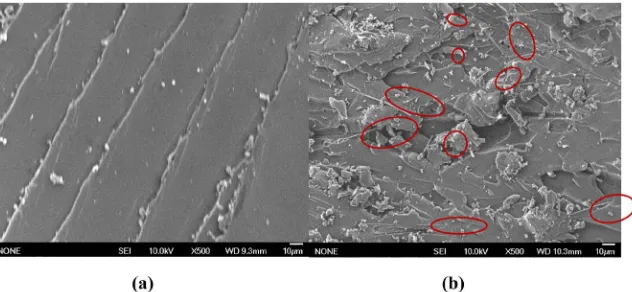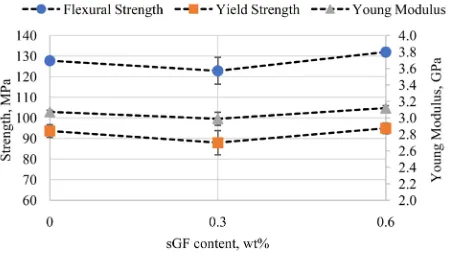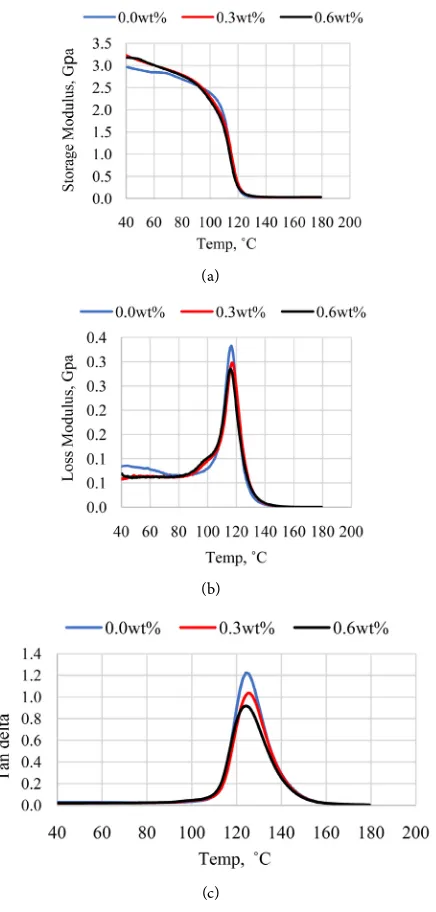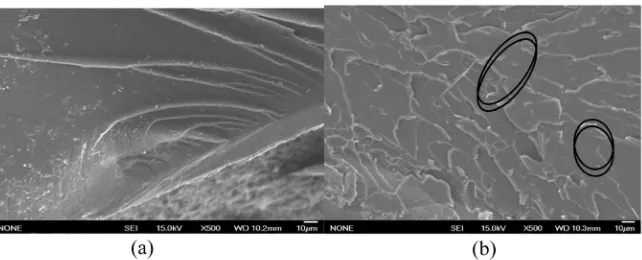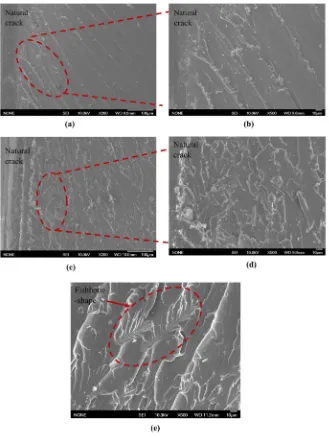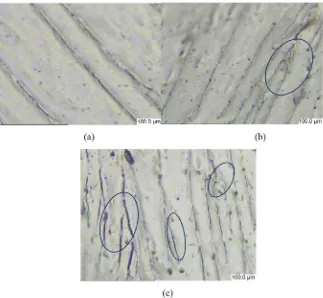ISSN Online: 2164-5655 ISSN Print: 2164-5612
DOI: 10.4236/ojcm.2019.94023 Oct. 12, 2019 365 Open Journal of Composite Materials
Mechanical Properties of Submicron Glass
Fiber Reinforced Vinyl Ester Composite
Nguyen T. T. Nhan1*, K. Obunai1, K. Okubo1, O. Shibata2, H. Tomokuni2, Y. Fujita2
1Department of Mechanical and Systems Engineering, Graduate School/Faculty of Science and Engineering, Doshisha University,
Kyotanabe, Kyoto, Japan
2DIC Corporation, Tokyo, Japan
Abstract
Vinyl ester (VE) resin inherently has intrinsic brittleness due to its high cross-link density. To improve mechanical performance, micro/nano fillers are widely used to modify this matrix. In present study, glass fiber in submi-cron scale at low contents was added into VE to prepare submisubmi-cron compos-ite (sMC). The impact resistance of un-notched sMC degraded with the in-crease of sGF content while that of notched-sMC remained the unchanged. Flexural properties of sMCs also were the same with that of neat resin. The results of Dynamic mechanical analysis (DMA) test showed the slight in-crease of storage modulus and the dein-crease of tan delta value in the case of sMC compared to those of un-filled matrix. However, the Mode I fracture toughness of sMC improved up to 26% and 61% corresponding to 0.3 and 0.6 wt% glass fiber used. The compact tension sample test suggests that there is the delay of crack propagation under tensile cyclic load in resin reinforced by submicron glass fiber. The number of failure cycle enlarged proportionally with the increment of sGF content in matrix.
Keywords
Submicron Glass Fiber, Vinyl Ester Resin (VE), Micro-Nano Composite, Submicron Composite, Modify
1. Introduction
Vinyl ester resins are typically formulated from styrene and a condensation product of methacrylic acid with an epoxy. Because the reactive double bonds are at the ends of relatively long chains, their cross-link density tends to be lower than the standard polyester resins. Therefore, it may also be regarded as filling
How to cite this paper: Nhan, N.T.T., Obunai, K., Okubo, K., Shibata, O., Tomokuni, H. and Fujita, Y. (2019) Me-chanical Properties of Submicron Glass Fiber Reinforced Vinyl Ester Composite. Open Journal of Composite Materials, 9, 365-377.
https://doi.org/10.4236/ojcm.2019.94023
Received: August 30, 2019 Accepted: October 9, 2019 Published: October 12, 2019
Copyright © 2019 by author(s) and Scientific Research Publishing Inc. This work is licensed under the Creative Commons Attribution International License (CC BY 4.0).
http://creativecommons.org/licenses/by/4.0/
DOI: 10.4236/ojcm.2019.94023 366 Open Journal of Composite Materials
the gap between epoxy resin and polyester resin in both sides of mechanical property as well as effective economy [1][2][3][4]. Thanks to good toughness, excellent resistance, good mechanical properties, outstanding heat performance, and flexible processibility compared to unsaturated polyester, VE is being in-creasingly used in solvent storage tanks, sewer pipes, ship and boat construction, coating, automobile structural parts, swimming-pool [5] [6]. Similar to other thermosets, pure vinyl ester resin is inherently brittle due to their highly cross-linked structure. One approach to increase its performance is to modify with fillers at micro/nano scale [7]-[12]. There is a large number of studies con-ducted to investigate properties of vinyl ester resin reinforced by micro/nano particles. Vahid Arabli et al. studied in curing kinetics, modeling, mechanical properties and thermal stability in graphene oxide/vinyl ester resin nanocompo-site [13]. They claimed that with a low content of graphene oxide (0.3%), the matrix became stiffer while the glass transition temperature shifted to a higher value. Dipa Ray used fly ash had a particlesize distribution in the range of 76 to 152 µm to fill in VE matrix [14]. Auad et al. modified vinyl ester resin of differ-ent molecular weights by rubber. The research group claimed that the addition of elastomers produces toughening of the networks, but at the same time a re-duction of their mechanical properties such as flexural modulus and compres-sion yield stress [15]. S. Grishchuk et al. investigated about structure and prop-erties of vinyl ester resins modified with organophilic synthetic layered silicates bearing non- and co-reactive intercalants. They found that fracture toughness (Kc) and energy (Gc) were markedly improved with increasing organophilic synthetic layered silicates amount [16]. However, along with restriction of load-ing content in polymer, the size of nano fillers is close to the molecular scale, leading to detrimental effects on properties of filled system because of interca-lating of nano particles and base material [17] Therefore, submicron particles have been considered as filled-gap material between nano and micro filler in re-cent years. In spite of that, in the best authors’ knowledge, there was still very few literature about using micro-nano filler for polymer matrix [18][19][20]. In this study, the submicron glass fiber (sGF) with diameter in the range of mi-cro-nano scale used to reinforce vinyl ester resin at low content to facilitate us-ing experimental data for further research of carbon fiber composite after that. Mechanical properties were characterized to access effects of sGF on submicron composite (sMC) system.
2. Materials and Experiments
2.1. Materials
DOI: 10.4236/ojcm.2019.94023 367 Open Journal of Composite Materials
to 2.4 µm and length of 20 to 200 µm and minority of length reaches 1 mm (Figure 1). All materials used without any further treatment.
2.2. Preparation of Sub-Micron Composite
After eliminating absorbed moisture in the dry oven for 12 hours at 60˚C, sGF was put into the stainless steel cup of the homogenizer and mixed with resin at speed of 5000 rpm for 30 minutes followed by adding hardener and promoter and mixed again by the plastic bar. The mixture was applied vacuum pressure to remove air bubbles trapped in resin during mixing until no bubbles remained on the surface of resin cup when observed by naked-eyes. To limit styrene evapo-rated, the vacuum time and vacuum pressure were controlled. The mixture of resin and glass fiber was gently poured into the mould, silently kept for 15 min-utes to facilitate bubbles escaped, followed by casting process in the dry oven for 3 hours at 80˚C and post-cured at 100˚C with the same time. The plate of sMC after that was cut into coupon specimens by the diamond cutter. The plate of neat resin also prepared in the same mould with the same processing conditions.
2.3. Izod Resistance Test
The impact resistance test of neat resin and sMC was performed using the pen-dulum testing device according to the standard ASTM D4812 for unnotched sample and D256 for notched-sample. The test was conducted when the hammer impacted onto the edge of specimen for both of the notched and the un-notched. At least 10 specimens were used for each sample group.
2.4. Three-Point Bending Test
The three-point bending test was carried out on the Autograph 100 kN tester (Shimadu Corp) at the speed of 2 mm/min, the support length of 60 mm fol-lowing the standard ASTM D790. At least five specimens were prepared for each condition. The yield strength as well as young modulus were calculated by de-termining 0.2% offset yield stress from stress-strain graph achieved on computer during the test.
[image:3.595.214.541.554.692.2](a) (b)
DOI: 10.4236/ojcm.2019.94023 368 Open Journal of Composite Materials
2.5. Dynamic Mechanical Analysis
Dynamic mechanical analysis was performed on the DMA 7100 analyzer (Hi-tachi) using the tensile mode. In this study, samples were cut into small pieces with dimensions of 40 × 10 × 1 mm3 and the gage length of 20 mm. The digital
Vernier calliper was used to measure the dimension of the specimens before testing. The test conditions included the oscillation frequency of 1 Hz, the range of temperature from 40˚C to 180˚C and the ramping speed of 3˚C/min.
2.6. Preparation of Plain Strain Fracture Toughness Sample
To characterize the toughness of neat VE and sMC in terms of the criti-cal-stress-intensity factor (KIc), the Single Edge Notch Bending (SENB) geometry
samples were prepared. The SENB was cut from the casted resin plate with the sharp-notch was created by tapping the edge of specimen to a round-cutting saw and the natural crack was generated by tapping on a fresh razor blade placed in the notch. The dimensions of specimens of 45 × 40 × 5 mm3 and notch length of
5 mm were prepared.
2.7. Scanning Electron Microscope (SEM) Observation
Dispersed statement of sGF inside matrix after mixing as well as fracture sur-faces of specimens after tests were observed by SEM equipment JSM 7001FD. Prior to SEM observation, all specimens were subjected to sputter coating of a thin layer of gold to avoid electrical charging.
2.8. Preparation of Compact Tension Sample
[image:4.595.236.510.547.703.2]The compact tension (CT) sample was drawn up by pouring resin into silicone molds followed by the processing of curing and post-curing in dry oven. For the sake of understanding resistance against crack propagation in matrix, a cyclic tension load was applied on samples at maximum load of 150 N, load ratio of 0.2 and frequency of applied load was 1 Hz. The geometry of CT sample was shown as in Figure 2.
DOI: 10.4236/ojcm.2019.94023 369 Open Journal of Composite Materials
3. Results and Discussion
3.1. Dispersion of sGF in Resin
Compared to neat resin matrix, it can be seen that the submicron glass fiber was well-dispersed inside VE matrix of composite (Figure 3(a) and Figure 3(b)). The length as well as the diameter of glass fiber after mixing also found was pretty different. This proves that conventional mixing technique is suitable for distributing sGF into vinyl ester resin and the aspect ratio of glass fiber in VE matrix varies in a large range.
3.2. Izod Impact Resistance
The Izod impact resistance of sMC decreased with the addition of sGF in un-notched samples (see Figure 4). As mentioned by Chris DeArmitt [21], stresses concentrate around filler particulates which causes un-homogeneousness of filled system and then plays a role as flaws deteriorate the impact resistance of material. In the case of sGF, because of the large change of the aspect ratio, the larger length the larger stress concentration. These results also are good agree-ment with that of DMA in later section while the energy dissipation ability de-grades by adding of sGF. Whereas, the notched impact resistance was the same with all contents of sGF. Consequently, the ratio of the notched to the un-notched values decreases in the order of decreasing of sGF content in sMC: 0.6 wt% > 0.3 wt% > 0.0 wt%. In other words, this indicates increasing the con-tent of sGF in sMC, material becomes more sensitive to scratches or sharp fea-tures in the part design that may act like notches.
[image:5.595.216.532.546.692.2]3.3. Flexural Properties
Figure 5 shows bending properties of sMC at different contents of sGF rein-forcement. In general, there was no significant change in bending strength, yield strength as well as Young modulus when comparing those of neat resin with sMC. The tress-strain curves also point out the linear elastic behaviour of sMC under flexural load was almost the same regardless the concentration of glass
DOI: 10.4236/ojcm.2019.94023 370 Open Journal of Composite Materials
Figure 4. Izod impact resistance of sMC with respect to sGF contents.
Figure 5. Bending properties of sMC with respect to sGF contents.
fiber (see Figure 6). Normally, the fillers with high aspect ratio such as glass fi-ber and carbon fifi-ber have high effectiveness in elevating flexural modulus as well as yield strength [21], but there was not the similar observation in this case. It might be caused by the low content of sGF used in VE matrix.
3.4. Dynamic Mechanical Property
As can be seen from the peak of the loss modulus curve as well as that of tan delta, the glass transition temperature (Tg) of resin was unchanged regardless the
presence of sGF (Figure 7(b) and Figure 7(c)). This indicates the fact that the cross-link density of polymer is not affected by sGF addition. However, the storage modulus of sMC was slightly higher than that of neat resin in the area far below Tg (from 40˚C - 85˚C). The damping characteristic of resin also decreased
with the increase of sGF content. It might be filler particulates absorb polymer chains into its surface, restrict the mobility of matrix molecular chains result in increasing of the elastic behaviour.
3.5. Fracture Toughness
[image:6.595.262.488.225.353.2]DOI: 10.4236/ojcm.2019.94023 371 Open Journal of Composite Materials
Figure 6. Typical stress-strain curves of sMC with respect to sGF contents.
(a)
(b)
(c)
[image:7.595.267.485.242.698.2]DOI: 10.4236/ojcm.2019.94023 372 Open Journal of Composite Materials
Figure 8. The fracture toughness of resin with respect to sGF content.
Figure 9. Fractured surface SEM images of (a) neat resin and (b) sMC with 0.6 wt% glass fiber after fracture toughness test.
sMC. These results suggest that the fracture toughness of matrixis effectively improved by mechanical bridging of added sGF at crack front.
3.6. Resistance against Crack Propagation
[image:8.595.215.536.261.391.2]DOI: 10.4236/ojcm.2019.94023 373 Open Journal of Composite Materials
Figure 10. The number of cycle to failure of neat resin and sMC specimens under ten-sion-tension loading condition.
[image:9.595.210.539.245.682.2]DOI: 10.4236/ojcm.2019.94023 374 Open Journal of Composite Materials
[image:10.595.212.535.204.502.2]Along with SEM images, the fracture surface of specimens also was used to observe the propagation of striations under the fatigue load by the lazer micro-scope (see Figure 12). With sMCs, the evidence of crack deflection is obviously detected at branched-off positions of crack growth lines (blue circles). As men-tioned by J. Petit [22], the striation spacing notifies observer the crack growth rate during a cycle. Figure 13 shows the striation spacing on the fracture surface of neat VE and sMCs, increasing the glass fiber content in matrix decreases the distance between adjacent striations and therefore, declines the crack growth
Figure 12. Lazer microscope images of fracture surface of (a) neat VE; (b) sMC at 0.3 wt% and (c) sMC at 0.6 wt% of sGF.
[image:10.595.248.500.551.706.2]DOI: 10.4236/ojcm.2019.94023 375 Open Journal of Composite Materials
rate. In other words, the enlargement of number of cycle to failure in sMCs is due to the delay of crack propagation owning to reinforcing effect of sGF. These results indicate that glass fiber plays important role in improving the fatigue life of resin by deflecting micro-crack lines, delaying the propagation of cracks as well as partly dissipating crack growth energy for de-bonding fibers from matrix.
4. Conclusions
The sGF was used as reinforcement in VE matrix at low content to investigate its effect on mechanical properties of sMC. Some results can be shown briefly as follows:
1) Submicron glass fiber was well-dispersed in resin by conventional mixing technique. The length of glass fiber after mixing was pretty varied leading to the huge variation of aspect ratio in VE matrix.
2) Impact resistance of un-notched sMC was decreased with the increase of sGF content in matrix while notched-impact resistance as well as flexural properties, was almost unchanged compared to those of neat resin. Dynamic mechanical analysis indicated the slight increase of elastic behavior and the de-crease of damping property in sMC. However, the Mode I fracture toughness improved significantly from 26% to 61% while the content of sGF lifted from 0.3 to 0.6 wt% in composite. Crack growth rate of notch specimens of sMC under tensile cyclic load also considerably degraded. The observation of SEM and lazer microscope shows that evidence of improving fatigue life of sMC is due to def-lecting micro-cracks and delaying the propagation of cracks as well as partly dis-sipating crack growth energy for de-bonding fibers from matrix.
Acknowledgements
The authors gratefully acknowledge Nippon Muki Co., Ltd. for the financial and material supports provided to this research.
Conflicts of Interest
The authors declare no conflicts of interest regarding the publication of this paper.
References
[1] Rao, B.S., Madec, P.J. and Marechal, E. (1986) Synthesis of Vinyl Ester Resins. Evi-dence of Secondary Reactions by13C NMR. Polymer Bulletin, 16, 153-157. https://doi.org/10.1007/BF00955485
[2] Mullins, M.J., Liu, D. and Sue, H.-J. (2017) Mechanical Properties of Thermosets. In: Guo, Q., Ed., Thermosets, 2nd Edition, Elsevier, Amsterdam, Netherlands, 35-67. https://doi.org/10.1016/B978-0-08-101021-1.00002-2
DOI: 10.4236/ojcm.2019.94023 376 Open Journal of Composite Materials [4] Varma, I.K. and Gupta, V.B. (2000) Thermosetting Resin-Properties. In: Kelly, A.
and Zweben, C., Eds., Comprehensive Composite Materials, Pergamon, London, 1-56.https://doi.org/10.1016/B0-08-042993-9/00177-7
[5] Kandola, B.K., Ebdon, J.R. and Zhou, C. (2018) Development of Vinyl Ester Resins with Improved Flame Retardant Properties for Structural Marine Applications. Re-active and Functional Polymers, 129, 111-122.
https://doi.org/10.1016/j.reactfunctpolym.2017.08.006
[6] Jaswal, S. and Gaur, B. (2014) New Trends in Vinyl Ester Resins. Reviews in Chemical Engineering, 30, 567-581.https://doi.org/10.1515/revce-2014-0012 [7] Ku, H., Prajapati, M. and Trada, M. (2012) Fracture Toughness of Vinyl Ester
Composites Reinforced with Sawdust and Postcured in Microwaves. International Journal of Microwave Science and Technology, 2012, Article ID: 152726.
https://doi.org/10.1155/2012/152726
[8] De LaCaBa, K. (2005) Properties of a Vinyl Ester Resin Modified with a Liquid Polymer. High Performance Polymers, 17, 605-616.
https://doi.org/10.1177/0954008305053206
[9] Ullett, J.S. and Chartoff, R.P. (1995) Toughening of Unsaturated Polyester and Vi-nylEster Resins with Liquid Rubbers. Polymer Engineering and Science, 35, 1086-1097.https://doi.org/10.1002/pen.760351304
[10] Orozco, R. (1999) Effects of Toughened Matrix Resins on Composite Materials for Wind Turbine Blades.Ph.D. Thesis, Montana State University, Bozeman, MT. [11] Marra, F., D’Aloia, A.G., Tamburrano, A., Ochando, I.M., De Bellis, G., Ellis, G. and
Sarto, M.S. (2016) Electromagnetic and Dynamic Mechanical Properties of Epoxy and Vinyl Ester-Based Composites Filled with Graphene Nanoplatelets. Polymers, 8, 272. https://doi.org/10.3390/polym8080272
[12] Burchill, P.J. and Simpson, G.J. (1997) Improved Interlaminar Fracture Toughness for Vinyl Ester Resin-Fiber Glass Composites. In: Proceedings of Eleventh Interna-tional Conference on Composite Materials, Volume 2, Fatigue, Fracture and Ce-ramic Matrix Composites Gold Coast, Queensland, Australia, 14th-18th July 1997. [13] Arabli, V. and Aghili, A. (2016) Graphene Oxide/Vinyl Ester Resin Nanocomposite:
The Effect of Graphene Oxide, Curing Kinetics, Modeling, Mechanical Properties and Thermal Stability. RSC Advances, 6, 22331-22340.
https://doi.org/10.1039/C5RA23731A
[14] Ray, D., Bhattacharya, D., Mohanty, A.K., Drzal, L.T. and Misra, M. (2006) Static and Dynamic Mechanical Properties of Vinylester Resin Matrix Composites Filled with Fly Ash. Macromolecular Materials and Engineering, 291, 784-792.
https://doi.org/10.1002/mame.200600097
[15] Auad, M.L., Proia, M., Borrajo, J. and Aranguren, M.I. (2002) Rubber Modified Vi-nyl Ester Resins of Different Molecular Weights. Journal of Materials Science,37, 4117-4126.https://doi.org/10.1023/A:1020031701950
[16] Grishchuk, S., Castella, N., Apostolov, A. and Kocsis, J. (2011) Structure and Prop-erties of Vinyl Ester Resins Modified with Organophilic Synthetic Layered Silicates Bearing Non- and Co-Reactive Intercalants. Journal of Composite Materials, 46, 941-947.https://doi.org/10.1177/0021998311413311
[17] Li, Y. (2007) The Development of Sub-Micron Filler Enhanced Polymer Compos-ites. Doctoral dissertation, Nottingham Trent University, Nottingham.
http://irep.ntu.ac.uk/id/eprint/192/1/194139_Yalan_thesis_final.pdf
DOI: 10.4236/ojcm.2019.94023 377 Open Journal of Composite Materials Poly(Styrene) and Nylon 3 by inSitu Polymerization. Polymer Journal, 28, 496-500. https://doi.org/10.1295/polymj.28.496
[19] Bogomolova, O.Y., et al. (2017) Effect of Adhesion between Submicron Filler Parti-cles and a Polymeric Matrix on the Structure and Mechanical Properties of Epoxy Resin Based Compositions. Mechanics of Composite Materials, 53, 117-122. https://doi.org/10.1007/s11029-017-9645-0
[20] Marquis, D.M., Guillaume, É. and Chivas-Joly, C. (2011) Properties of Nanofillers in Polymer, Nanocomposites and Polymers with Analytical Methods. InTech, Lon-don.
http://www.intechopen.com/books/nanocomposites-and-polymers-with-analytical
methods/properties-of-nanofillers-in-polymer
[21] DeArmitt, C. (2011) Functional Fillers for Plastics. In: Kutz, M., Ed., Applied Plas-tics Engineering Handbook Processing and Materials, Elsevier, Amsterdam, Neth-erlands, 455-468. https://doi.org/10.1016/B978-1-4377-3514-7.10026-1
